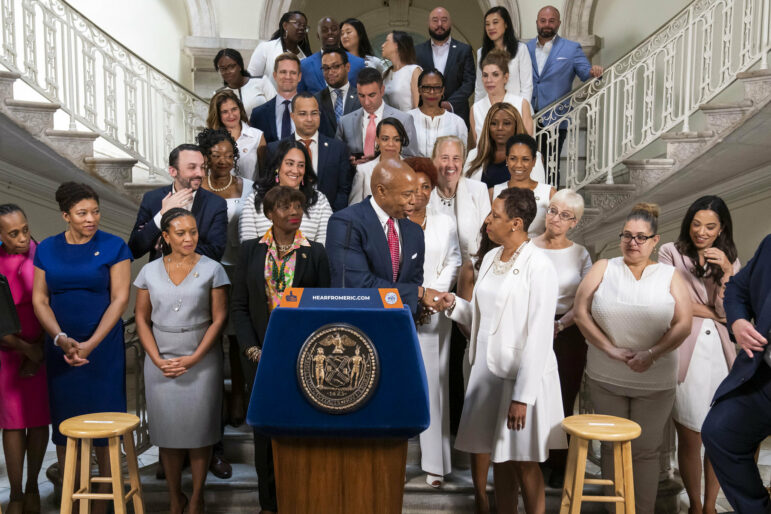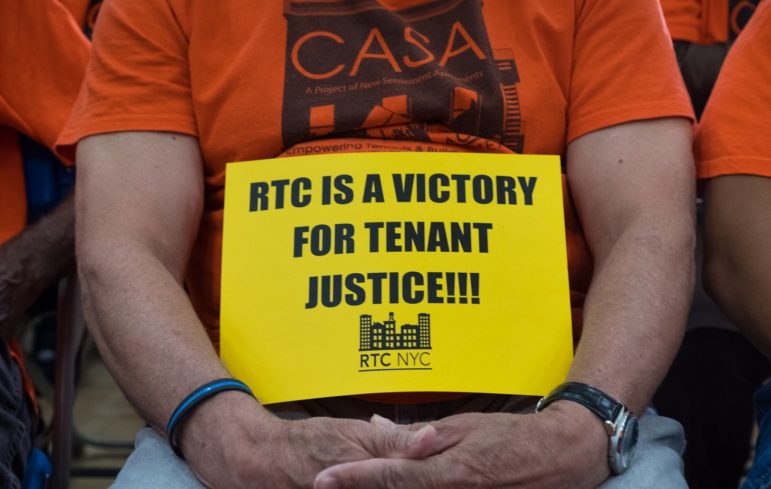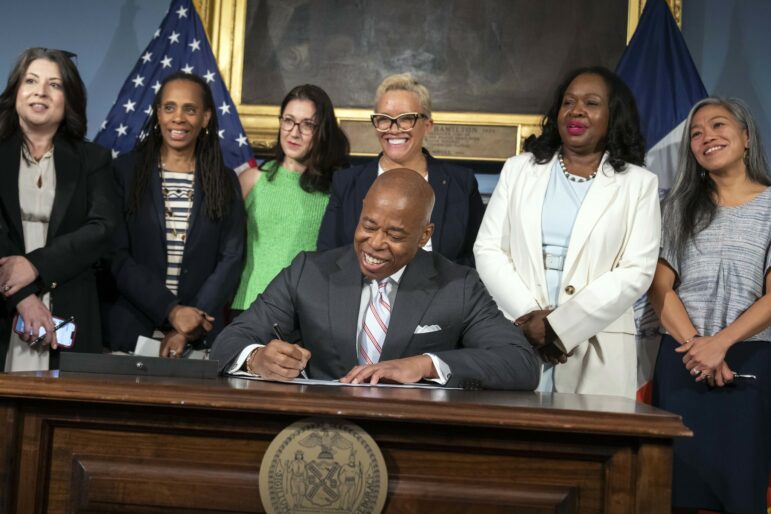Amid a record-breaking homelessness crisis, there are some bright spots. Mayor Adams has dedicated roughly $4 billion in capital funding to construct affordable housing—a campaign promise that he fell short on last year. Yet staffing cuts and shortages still plague the city agencies tasked with assisting homeless New Yorkers.

Ed Reed/Mayoral Photography Office
Mayor Eric Adams and Council Speaker Adrienne Adams shake hands on the Fiscal Year 2024 budget on June 29, 2023.
In the days since Mayor Eric Adams and Council Speaker Adrienne Adams shook hands on a $107 billion budget for the year starting July 1, housing and homelessness advocates and nonprofit staff have been squinting over budget documents to better understand where funding they rely on has been boosted, or cut.
Amid a record-breaking homelessness crisis, there are some bright spots. Mayor Adams has dedicated roughly $4 billion in capital funding to construct affordable housing—a campaign promise that he fell short on last year. Yet staffing cuts and shortages still plague the city agencies tasked with assisting homeless New Yorkers.
The budget also includes some new funding for rental vouchers. However, it does not account for the City Council’s imminent plan to override a vetoed legislative package that could dramatically expand eligibility for city-issued rental vouchers, known as CityFHEPS, with budget implications for years to come.
“There should be no mistake made—this council will shortly also be passing our CityFHEPS legislative package which will expand housing stability for New Yorkers… via expanded vouchers,” said Bronx Councilmember Pierena Sanchez, chair of the Housing and Buildings Committee, before voting in favor of the budget on June 30. “All of this is happening together.”
Here, City Limits breaks down New York City’s latest spending plan through the lens of housing and homelessness.
Construction funding boost
Since the 1990s, available low-cost apartments have dwindled in New York City, while the stock of more expensive apartments has been on the rise—a stark reality for low-income New Yorkers at risk of eviction, or living in shelter.
As a candidate, Mayor Adams pledged to commit $4 billion per year to build and upgrade affordable housing. Yet last year he sent a combined $2.5 billion to the Department of Housing Preservation and Development (HPD) and New York City Housing Authority (NYCHA).
This year’s $4 billion spending pot—including about $2.5 billion for HPD and $1.5 billion for NYCHA—is the level “this moment demands,” Speaker Adams said during the handshake press conference on June 29.
Brendan Cheney, director of policy and communications for the New York Housing Conference, said the boost in funding next year is welcome. “We were talking a lot about rising interest rates and rising construction costs and the need for more money,” he said. “And so having that much money in the budget next year is a really good thing.”
The move comes after HPD lowered its expectations for the year that ended in June, to 18,000 income-restricted units created or preserved, down from 25,000 units the year prior. A spokesperson for the department told City Limits that the agency is on track to surpass that 18,000 goal, though final data won’t be released for several weeks.
HPD made more than 600 hires last year, the spokesperson noted.
“We see that they’re staffing up,” said Alexa Sewell, president of nonprofit developer Settlement Housing Fund. “I definitely think that if there’s a will to spend it they will find a way.”
The adopted budget also shifts $175 million in capital funding closer to the present—from Fiscal Year 2026 to 2025—for building and rehabilitating low- and moderate-income housing, as well as supportive housing with accompanying services, such as counseling and health care referrals.
But even still, Cheney noted a significant drop in capital spending on housing into the future. Although the capital commitment plan won’t be updated until October to reflect these shifts, the New York Housing Conference has done its own math showing a drop to $2.7 billion in FY25, $2.2 billion in FY26, and $2 billion in FY27.
“Given the scale of the housing crisis, the need for robust housing funding is great, and we want the administration to be allocating $4 billion in the future years as well,” Cheney said.

Edwin J. Torres/Mayoral Photog
A tenant advocate holds a sign in support of the city’s Right to Counsel program.Partial leg-up to fight evictions
City Limits previously reported on new funding in the budget for attorneys who represent low-income tenants in housing court, to the tune of $20 million annually starting this year.
The legal services providers who administer New York City’s Right to Counsel program—which provides free eviction defense to qualifying low-income tenants—are still awaiting clarity on exactly how much of these funds will enhance their current contracts, which totaled $112 million last year.
Meanwhile, this year has seen a significant increase in eviction filings compared to 2022 in all five boroughs, though filings have yet to surpass pre-pandemic levels.
“Once we have more certainty around the numbers we are optimistic that we can add some additional staff,” Rosalind Black, citywide housing director at Legal Services NYC, said recently. But she stressed the new funding will not be enough to allow contractors to cover all qualifying tenants.
Service provider cuts
Making sense of the budget is particularly complicated for nonprofits who contract with the city, according to Catherine Trapani, executive director of Homeless Services United, a coalition of 50 nonprofit organizations serving homeless New Yorkers.
“Not only does it take us time to understand what even is in there, once we do understand what’s in there, applying it to the actual spending plans is a process,” she said.
Now Trapani’s members are beginning to grapple with spending cuts passed on to them through a Program to Eliminate the Gap, or PEG, announced in April and maintained in the budget—about $29 million annually through Fiscal Year 2027.
Each homeless services provider contracted by the city is now expected to reduce their spending by 2.5 percent, among other adjustments, Trapani explained. “People have been getting their savings targets from the department in the last week,” she said.
How these cuts manifest could vary from contract to contract. “It’s going to be looking at… what you can do without imminently harming safety,” Trapani said. This could mean cutting “a security guard, or a few lunches, in order to not reduce core social services.”
A spokesperson for the Department of Social Services (DSS) said the PEG is not expected to result in layoffs, and that the city is working to ensure “minimal impact” on providers. Tranpani, however, felt less confident in that assessment, saying layoffs are “entirely possible.”*
The move comes as a record number of people are sleeping in city shelters—nearly 82,000 as of Tuesday, a share of whom are immigrants housed in city-run emergency facilities.
This year’s budget separately includes $40 million to boost wages for nonprofit workers in the human services sector, on top of a $60 million annual boost secured last year.
“Securing pay increases for these workers, the majority of whom are women and people of color, is a matter of gender, racial, and economic justice,” Speaker Adams said during the budget handshake.
But providers had sought a 6.5 percent cost-of-living adjustment, or COLA, which they estimated would cost $200 million this year and compound annually.
For Department of Homeless Services contractors, Trapani said, the PEG cuts could potentially detract from any wage gains. “The idea that this is going to improve DHS take-home pay is really something I’m not sure of,” she said.
City staffing woes persist
Since the coronavirus pandemic hit New York City in March 2020, staff shortages at city agencies have been a persistent challenge, including in the offices tasked with spurring new development, keeping apartments safe, and moving New Yorkers from shelter into permanent housing.
This year, spending cuts introduced in November, January and April—and memorialized in the final budget—eliminated hundreds of vacant positions at housing and homelessness agencies, including 773 from the Human Resources Administration (HRA), 107 from the Department of Homeless Services (DHS), 46 from HPD, and 94 from the Department of Buildings (DOB).
The Commission on Human Rights, tasked with investigating discrimination by landlords as well as employers, saw 20 vacant roles cut in the adopted budget, records show. But the new spending plan also includes $1.3 million for 17 new hires, including lawyers, after a team focused on illegal source-of-income discrimination dwindled precipitously.
Reached for confirmation on these cuts, City Hall stressed that they do not amount to layoffs, since only unfilled positions were struck. The city noted that it is trying to hire aggressively across agencies, and that the cuts were made to help balance the budget amid an influx of asylum seekers.
A review of agency headcounts as of this month, provided by the Independent Budget Office, shows that HPD, responsible for housing development, has 2,418 staff—an increase since March that now surpasses its Dec. 2019 pre-pandemic headcount of 2,405.
Yet agencies that support homeless New Yorkers have yet to bounce back, based on data compiled by the IBO and New York Housing Conference. HRA had 10,853 staff as of July 6, down from 12,528 in Dec. 2019, while DHS had 1,801 staff compared to 2,257 pre-covid.

Ed Reed/Mayoral Photography Office.
Voucher question mark
The city has budgeted about $280 million for CityFHEPS vouchers for the coming year, $123 million of which has been earmarked to cover the costs of eliminating a once mandatory 90-day waiting period before shelter residents could apply.
Under the voucher program, established in 2018, most recipients pay part of their income in rent, up to 30 percent, and the city covers the rest, up to a fixed maximum. As of May, 26,500 households use the vouchers, according to City Hall.
Mayor Adams eliminated the 90-day rule in June through executive action, even as he declined to sign City Council bills that would further expand voucher eligibility. Those bills are teed up for a veto override Thursday.
This year’s voucher funding is greater than the $237 million initially budgeted for last year. However, the city ended up increasing that amount over time, landing ultimately at about $420 million, budget documents show.
It is not uncommon for City Hall to increase the CityFHEPS budget throughout the year, according to Sean Campion, director of housing and economic development studies at the Citizens Budget Commission, or CBC, a nonprofit fiscal watchdog.
“They’ll add money as the fiscal year goes along based on how the program is being used and how many vouchers are out there,” he told City Limits. “They added more this year than they did in the past, but are still under-budgeting… before you get into any expansions.”
Mayor Adams has opposed the City Council voucher bills on the basis of cost, saying they could require $17.2 billion over five years. But supporters of the package have played up the potential for significant shelter-side savings.
In addition to fiscal concerns raised by groups like the CBC, some critics have also warned that the city lacks the staff needed to administer an expanded voucher program.
City Limits spoke with a broker who helps voucher holders find apartments, who described a limbo for clients waiting for their payments to process. The person requested anonymity as they did not have their employer’s permission to speak.
“Right now I have over eight people where they’ve been approved for units and we’re just sitting here twiddling our thumbs,” they said. “We don’t know where the money is, nobody’s responding.”
Jennifer March, executive director of the Citizens’ Committee for Children of New York (a City Limits funder), agreed that more staff are needed to administer vouchers. But she said the city should find a way to increase staffing rather than shy away from legislation that could prevent people from entering a shelter system that can be traumatic, particularly for children.
“We want the vouchers to be more expeditiously accessible to prevent more costly shelter stays,” she said. “Not only costly in fiscal terms but in human terms.”
*This story has been updated since original publication to include comment from the Department of Social Services and further comment from Trapani.








